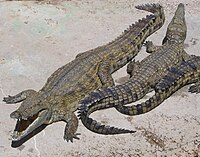
Photo from wikipedia
Harmful effects of several pollutants have been reported on early life stages of fish. However, the effects of palm oil mill effluent (POME) on fish early life stages are still… Click to show full abstract
Harmful effects of several pollutants have been reported on early life stages of fish. However, the effects of palm oil mill effluent (POME) on fish early life stages are still unexplored. Therefore, the objective of this present study was to elucidate the impact of POME on the early life stages of Nile tilapia (Oreochromis niloticus). Fertilized eggs of Nile tilapia were exposed to four concentrations of POME (0, 1.565, 2.347, and 3.130 mg/L) in 20 plastic funnels. Each of the control and treatment groups was maintained in five replicates. The cumulative hatching rate, malformation rate, body length, and deformities of larvae were analyzed. Results showed that hatching rate and survival rate of Nile tilapia larvae significantly decreased with increasing concentrations of POME. In contrast to, malformation rate and heart rate were significantly increased. Furthermore, results showed several malformations of Nile tilapia larvae including lordosis, kyphosis, and curved tail when exposed to 1.565 mg/L, 2.347 mg/L, and 3.130 mg/L of POME concentrations. Further research is required to understand the physiological mechanisms of different endpoints in the early stages of Nile tilapia induced by the toxicity of POME.
Journal Title: Environmental Science and Pollution Research
Year Published: 2020
Link to full text (if available)
Share on Social Media: Sign Up to like & get
recommendations!